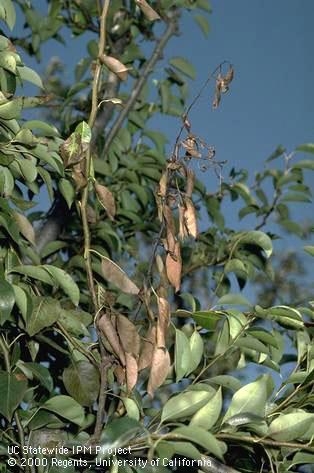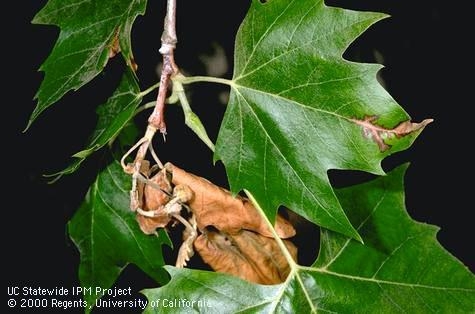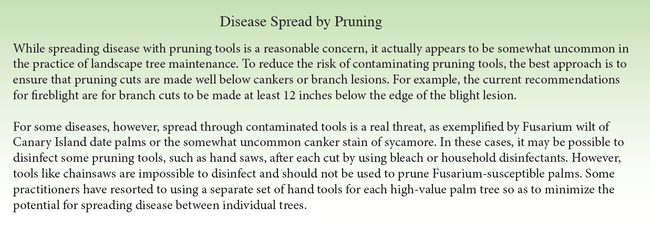
Formative pruning: A young tree arriving from the nursery or getting established in its first few years in the landscape often requires pruning, over multiple seasons, to guide the tree to a site-appropriate mature form. This is the best time to correct, by pruning, any structural deficiencies, such as co-dominant leaders, rubbing or overlapping branches, or girdling roots. In most cases, these structural problems are not “self-correcting,” making pruning a necessary measure. Importantly, a young tree is not only better able to tolerate the removal of live biomass than a mature tree (i.e., the “pruning dose” can be larger – up to 50% of foliage might be removed from a newly-planted tree), but the pruning cuts themselves are made on small branches and are thus smaller and more rapidly sealed over, minimizing the likelihood of infection by plant pathogens or wood decay fungi. A number of printed and on-line instruction manuals are available demonstrating the goals and methods of formative pruning, such as articles and leaflets, from the University Of California and Tree Cue Cards from CAL FIRE.
Corrective pruning: In cases where formative pruning was neglected or was insufficient, or where a tree has suffered some physical damage (e.g., from storms or vandalism), pruning can be useful in correcting defects like broken or overlapping branches, double leaders, or poor branch spacing on mature trees. Corrective pruning aims for minimally-sized, properly located pruning cuts that promote successful “compartmentalization;” that is, cuts that allow the tree to seal over with callus tissue on the outside, and that limit the spread inside the tree of any decay organisms that may invade. Proper pruning cuts are always preferable to failures (e.g., breaks or “tear-outs”) of branches or leaders, which are often caused by un-corrected structural defects and which frequently result in large wounds that compartmentalize poorly (e.g., because they are located mid-branch, or they tear away large strips of bark) and remain a major invasion pathway for pathogens or wood decay fungi.
The “pruning dose” for corrective pruning should be smaller than for formative pruning, not exceeding about 25% of foliage removal from an established tree. As little as 10% foliage removal is the recommended maximum for older, mature trees.
Eradicative pruning: It is possible in some cases to use pruning as “surgery” to remove infected parts from trees, thus removing (eradicating) disease. Several diseases can be managed in this way, including some canker pathogens (like branch cankers), and tip necroses (like fire blight), and even some insect infestations. For plant diseases, the effectiveness of eradicative pruning varies by pathogen as some spread quickly through the tree, and are typically systemic by the time symptoms appear (e.g., vascular wilts). The effectiveness also varies by tree size and accessibility of the infected/infested branches. For example, Pitch canker in Monterey pine is usually a set of individual infections from branch tips that can be cut off to reduce the disease, but pruning away the multiple infected branchlets may be impractical on a large or tall tree. Fireblight, on the other hand, often occurs on smaller-stature trees, and can be successfully managed by removing infested branches well below the canker margin. In using this approach to manage pathogens, it is important that the pruning cut be made well below (8-12 inches or so) any infected tissue, so as to both remove all of the infected tissue and to prevent contamination of the pruning tool (see box at right). While the extent of some infestations on a tree branch is quite obvious, for other diseases you may have to look for subtle symptoms such as sunken or discolored bark, or wilted foliage to identify the margins of infection.


Resource List
CAL FIRE Tree Cue Cards http://www.fire.ca.gov/resource_mgt/resource_mgt_urbanforestry.php
UCCE Ventura County Pruning Small Trees and Shrubs http://ceventura.ucanr.edu/Environmental_Horticulture/Landscape/Pruning/
UC Center for Landscape and Urban Horticulture http://ucanr.edu/sites/UrbanHort/files/80115.pdf
UC IPM Pest Notes
Fire Blight http://www.ipm.ucdavis.edu/PMG/PESTNOTES/pn7414.html
Pitch Canker http://www.ipm.ucdavis.edu/PMG/PESTNOTES/pn74107.html
Anthracnose http://ucipm.ucdavis.edu/PMG/PESTNOTES/pn7420.html
Powdery Mildew http://www.ipm.ucdavis.edu/PMG/PESTNOTES/pn7493.html
Palm Diseases (Fusarium Wilt) http://www.ipm.ucdavis.edu/PMG/PESTNOTES/pn74148.html#FUSARIUM
UC IPM Pest pages
Branch Canker http://www.ipm.ucdavis.edu/PMG/GARDEN/PLANTS/DISEASES/cankerdiseases.html
Vascular Wilts http://www.ipm.ucdavis.edu/PMG/GARDEN/PLANTS/DISEASES/fusariumwlt.html
Canker Stain http://www.ipm.ucdavis.edu/PMG/GARDEN/PLANTS/DISEASES/cankerstain.html
Author - Interim County Director; Bay Area Environmental Horticulture and Urban Forestry Advisor